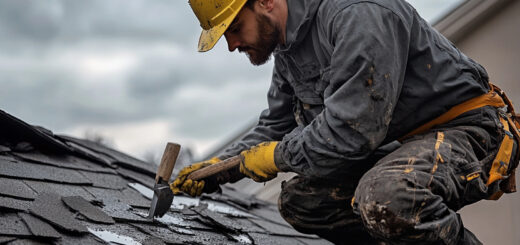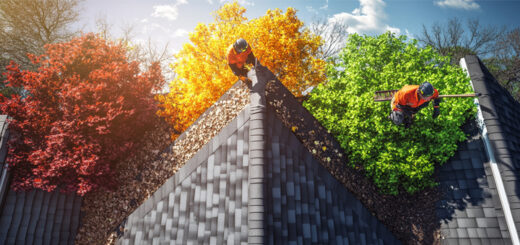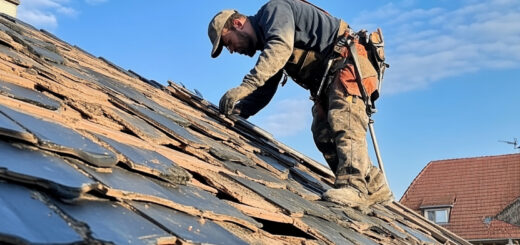The Ultimate Guide to Commercial Roof Fixes
When it comes to maintaining a commercial property, the roof is one of the most critical components. Understanding commercial roof repairs is essential for ensuring the longevity and safety of your building. Commercial roofing maintenance involves regular inspections and timely interventions to address potential issues before they escalate into costly problems.
There are various types of commercial roofs, each with its unique characteristics and repair needs. Flat roofs, for instance, are common in commercial buildings due to their cost-effectiveness and ease of installation. However, they require vigilant maintenance to prevent water pooling and leaks. Metal roofs, on the other hand, are known for their durability but may need periodic sealing and rust prevention treatments.
Roof fix solutions can range from simple patching jobs to more extensive repairs such as replacing damaged sections or addressing underlying structural issues. By staying informed about these different aspects of commercial roof repairs, property managers can make better decisions that prolong the life of their roofing systems and protect their investments.
Common Issues That Require Commercial Roof Repairs
Commercial roofs are essential to the integrity and functionality of any business establishment, but they are also prone to various issues that necessitate timely repairs. One of the most common problems is roof leaks, which can lead to significant water damage if not addressed promptly. Water seeping through the roof can compromise the structural integrity of the building and create a breeding ground for mold and mildew.
Roof punctures are another frequent issue, often caused by foot traffic or falling debris. These small openings may seem insignificant at first but can quickly expand and allow water to penetrate the roofing system. Weather-related damage is also a major concern, with high winds, hail, and heavy snowfall posing serious threats to commercial roofs. Such conditions can strip away protective layers or cause physical damage that weakens the overall structure.
Structural issues often arise from poor installation practices or aging materials. Over time, these problems can escalate, leading to sagging areas or even partial collapses if left untreated. Regular inspections and maintenance are crucial for identifying these vulnerabilities early on.
In summary, addressing roof leaks, water damage, roof punctures, weather-related damage, and structural issues promptly is vital for maintaining a safe and operational commercial space.
The Importance of Regular Maintenance for Commercial Roofs
Regular maintenance for commercial roofs is crucial to ensure the longevity and efficiency of the roofing system. Preventive maintenance, which includes routine inspections, can help identify potential issues before they become major problems. By addressing minor repairs early on, businesses can significantly extend the life of their roofs.
Routine inspections allow for early detection of wear and tear, leaks, or structural damage that could compromise the integrity of the roof. This proactive approach not only enhances roof longevity but also translates to substantial cost savings on repairs in the long run. Instead of facing expensive emergency repairs or complete roof replacements, regular maintenance helps manage costs more effectively by spreading out minor repair expenses over time.
In summary, investing in preventive maintenance and routine inspections is a smart strategy for any business looking to maximize their roof’s lifespan and minimize unexpected repair costs.
Diverse Types of Commercial Roofing Materials and Their Repair Needs
When it comes to commercial roofing, understanding the different types of materials and their specific repair needs is crucial for maintaining the integrity and longevity of your building. Each roofing material has unique properties that dictate how it should be cared for and repaired.
TPO (Thermoplastic Olefin) roofing is a popular choice due to its energy efficiency and durability. However, TPO roofing repairs are often needed for issues like seam failures or punctures. Regular inspections can help identify these problems early, ensuring timely fixes that prevent more extensive damage.
EPDM (Ethylene Propylene Diene Monomer) is another common commercial roofing material known for its resilience and flexibility. EPDM roofing fixes typically involve addressing leaks around seams or flashings. Proper maintenance includes regular roof cleaning to remove debris that can cause membrane deterioration over time.
Metal roofs are valued for their longevity and strength but aren’t without their own set of repair needs. Metal roof repairs often focus on addressing rust spots, loose fasteners, or damaged panels. Routine inspections and timely touch-ups with protective coatings can significantly extend the life of a metal roof.
Flat roofs, which are prevalent in commercial buildings, require diligent flat roof maintenance to prevent water pooling and subsequent leaks. Regular checks for cracks, blisters, or membrane separations are essential in keeping a flat roof in optimal condition.
By understanding the specific repair needs associated with TPO, EPDM, metal roofs, and flat roofs, property managers can implement effective maintenance strategies that safeguard their investments while ensuring the safety and comfort of building occupants.
Signs Your Commercial Roof Needs Immediate Attention
Maintaining the integrity of your commercial roof is crucial for protecting your business and ensuring the safety of everyone inside. Recognizing the signs that your roof needs immediate attention can prevent minor issues from becoming costly repairs. Here are some key indicators to watch out for:
Visible Damage Signs: Regular inspections can reveal visible damage such as cracks, punctures, or missing shingles. These damages often indicate that the roof’s protective layer has been compromised, exposing it to further deterioration.
Interior Leaks and Stains: Water stains on ceilings or walls are clear signs of a leaking roof. Interior leaks not only damage property but can also lead to mold growth, posing health risks to occupants.
Increased Energy Bills: A sudden spike in energy costs may be linked to poor insulation caused by roofing problems. Damaged roofs allow heated or cooled air to escape, forcing HVAC systems to work harder and increasing energy consumption.
Sagging Areas in the Roof Structure: Sagging sections of a roof are a serious concern and often signal structural issues that need immediate attention. This could be due to water accumulation, weakened materials, or underlying support problems.
Addressing these signs promptly with professional help can safeguard your commercial property from extensive damage and ensure its longevity.
Selecting a Professional for Your Commercial Roofing Repairs
When it comes to selecting a professional for your commercial roofing repairs, making an informed decision is crucial to ensuring the longevity and quality of your roof. Choosing a roofing contractor involves several key considerations that can significantly impact the outcome of your project.
Firstly, prioritize certified roofing specialists. Certification indicates that the contractor has undergone rigorous training and meets industry standards. Certified professionals are more likely to deliver high-quality work and adhere to safety protocols.
Next, comparing quotes and services is essential. Obtain detailed estimates from multiple contractors to understand the scope of work, materials used, and overall costs involved. This step not only helps you gauge market rates but also allows you to assess which services are included in each quote. Look beyond price alone; consider factors such as warranty offerings, project timelines, and customer reviews.
By carefully evaluating certified roofing specialists and thoroughly comparing quotes and services, you can select a reliable contractor who will provide effective solutions for your commercial roofing repairs. This thoughtful approach will help ensure that your investment is well-protected with a durable and expertly repaired roof.
The Cost of Commercial Roof Fixes: What to Expect
When it comes to maintaining a commercial property, one of the significant expenses you may encounter is roof repair. Understanding the cost of commercial roof fixes can help you budget more effectively and avoid unexpected financial strain.
Repair Costs Breakdown by Material Type and Issue Severity
The cost of repairing a commercial roof largely depends on two main factors: the type of roofing material and the severity of the issue. Here’s a detailed breakdown:
Material Type
- Asphalt Shingles: Commonly used due to their affordability, asphalt shingles typically cost between $5 to $10 per square foot for repairs.
- Metal Roofing: Known for its durability, metal roofing repair costs range from $7 to $15 per square foot.
- EPDM Rubber: This material is popular for flat roofs and costs approximately $8 to $12 per square foot for repairs.
- TPO Roofing: Thermoplastic Olefin (TPO) roofing is another choice for flat roofs, with repair costs averaging between $9 to $14 per square foot.
Issue Severity
- Minor Leaks: Small leaks or punctures usually require minimal labor and materials, costing around $300 to $600.
- Moderate Damage: Issues such as partial membrane replacement or fixing multiple leaks can range from $1,000 to $3,000.
- Severe Damage: Extensive damage that requires structural repairs or full sections replacement can escalate costs significantly, often exceeding $5,000.
By understanding these cost factors, property managers and business owners can better prepare for potential expenses related to their commercial roofs. Regular maintenance and timely repairs are crucial in extending the life of your roof while managing overall costs effectively.












